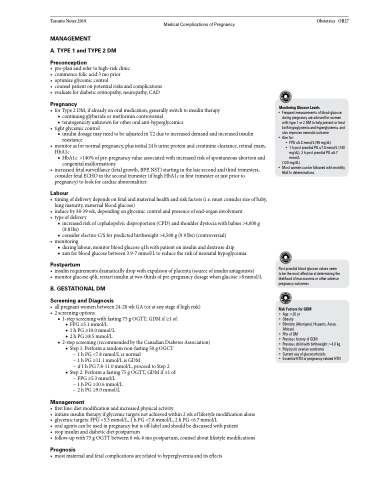Page 867 - TNFlipTest
P. 867
Toronto Notes 2019
Medical Complications of Pregnancy
Obstetrics OB27
MANAGEMENT
A . TYPE 1 and TYPE 2 DM
Preconception
• pre-planandrefertohigh-riskclinic
• commencefolicacid3moprior
• optimizeglycemiccontrol
• counselpatientonpotentialrisksandcomplications • evaluatefordiabeticretinopathy,neuropathy,CAD
Pregnancy
• forType2DM,ifalreadyonoralmedication,generallyswitchtoinsulintherapy ■ continuing glyburide or metformin controversial
■ teratogenicity unknown for other oral anti-hyperglycemics
• tight glycemic control
■ insulin dosage may need to be adjusted in T2 due to increased demand and increased insulin
resistance
• monitorasfornormalpregnancy,plusinitial24hurineproteinandcreatinineclearance,retinalexam,
HbA1c
■ HbA1c: >140% of pre-pregnancy value associated with increased risk of spontaneous abortion and
congenital malformations
• increasedfetalsurveillance(fetalgrowth,BPP,NST)startinginthelatesecondandthirdtrimesters,
consider fetal ECHO in the second trimester (if high HbA1c in first trimester or just prior to pregnancy) to look for cardiac abnormalities
Labour
• timingofdeliverydependsonfetalandmaternalhealthandriskfactors(i.e.mustconsidersizeofbaby, lung maturity, maternal blood glucose)
• induceby38-39wk,dependingonglycemiccontrolandpresenceofend-organinvolvment
• typeofdelivery
■ increased risk of cephalopelvic disproportion (CPD) and shoulder dystocia with babies >4,000 g (8.8 lbs)
■ consider elective C/S for predicted birthweight >4,500 g (9.9 lbs) (controversial)
• monitoring
■ during labour, monitor blood glucose q1h with patient on insulin and dextrose drip
■ aim for blood glucose between 3.9-7 mmol/L to reduce the risk of neonatal hypoglycemia
Postpartum
• insulinrequirementsdramaticallydropwithexpulsionofplacenta(sourceofinsulinantagonists)
• monitorglucoseq6h,restartinsulinattwo-thirdsofpre-pregnancydosagewhenglucose>8mmol/L
B . GESTATIONAL DM
Screening and Diagnosis
• allpregnantwomenbetween24-28wkGA(oratanystageifhighrisk) • 2screeningoptions
■ 1-step screening with fasting 75 g OGTT; GDM if ≥1 of: ◆ FPG ≥5.1 mmol/L
◆ 1 h PG ≥10.0 mmol/L
◆ 2 h PG ≥8.5 mmol/L
■ 2-step screening (recommended by the Canadian Diabetes Association) ◆ Step 1: Perform a random non-fasting 50 g OGCT
– 1 h PG <7.8 mmol/L is normal
– 1 h PG ≥11.1 mmol/L is GDM
– if 1 h PG 7.8-11.0 mmol/L, proceed to Step 2
◆ Step 2: Perform a fasting 75 g OGTT, GDM if ≥1 of: – FPG ≥5.3 mmol/L
– 1 h PG ≥10.6 mmol/L
– 2 h PG ≥9.0 mmol/L
Management
• firstline:dietmodificationandincreasedphysicalactivity
• initiateinsulintherapyifglycemictargetsnotachievedwithin2wkoflifestylemodificationalone • glycemictargets:FPG<5.3mmol/L,1hPG<7.8mmol/L,2hPG<6.7mmol/L
• oralagentscanbeusedinpregnancybutisoff-labelandshouldbediscussedwithpatient
• stopinsulinanddiabeticdietpostpartum
• follow-upwith75gOGTTbetween6wk-6mopostpartum,counselaboutlifestylemodifications
Prognosis
• mostmaternalandfetalcomplicationsarerelatedtohyperglycemiaanditseffects
Monitoring Glucose Levels
•
•
•
Frequent measurements of blood glucose during pregnancy are advised for women with type 1 or 2 DM to help prevent or treat both hypoglycemia and hyperglycemia, and also improves neonatal outcome
Aimfor:
• FPG ≤5.3 mmol/L (95 mg/dL)
• 1 h post prandial PG ≤7.8 mmol/L (140
mg/dL), 2 h post prandial PG ≤6.7
mmol/L (120 mg/dL)
Most women can be followed with monthly HbA1c determinations
Post-prandial blood glucose values seem to be the most effective at determining the likelihood of macrosomia or other adverse pregnancy outcomes
Risk Factors for GDM
• Age >25 yr
• Obesity
• Ethnicity (Aboriginal, Hispanic, Asian,
African)
• FHx of DM
• Previous history of GDM
• Previous child with birthweight >4.0 kg • Polycystic ovarian syndrome
• Current use of glucocorticoids
• Essential HTN or pregnancy-related HTN


